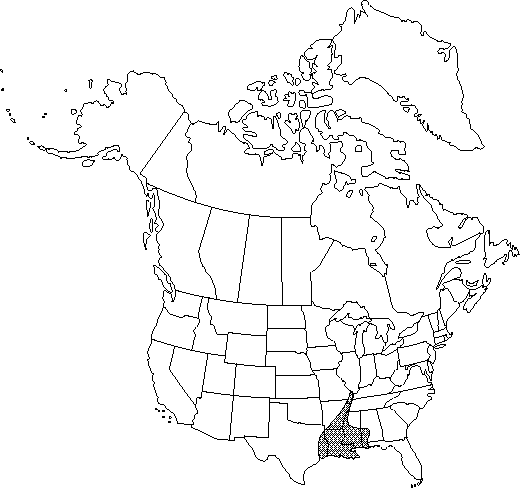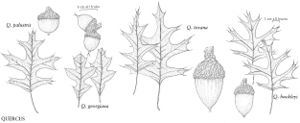Difference between revisions of "Quercus texana"
Proc. Acad. Nat. Sci. Philadelphia 12: 444. 1860.
FNA>Volume Importer |
FNA>Volume Importer |
||
| Line 33: | Line 33: | ||
}}<!-- | }}<!-- | ||
| − | --><span class="statement" id="st- | + | --><span class="statement" id="st-undefined" data-properties=""><b>Trees,</b> deciduous, to 25 m. <b>Bark</b> dark brown with flat ridges divided by shallow fissures. <b>Twigs</b> red-brown to gray, 1.5-3(-3.5) mm diam., glabrous. <b>Terminal</b> buds gray to gray-brown, ovoid, 3-7 mm, glabrous or with scales somewhat ciliate at apex. <b>Leaves</b>: petiole 20-50 mm, glabrous. <b>Leaf</b> blade ovate to elliptic or obovate, 75-200 × 55-130 mm, base cuneate to almost truncate, often inequilateral, margins with 6-11 lobes and 9-24 awns, lobes oblong to distally expanded, rarely falcate, apex acute; surfaces abaxially glabrous except for conspicuous axillary tufts of tomentum, veins raised, adaxially planar, glabrous. <b>Acorns</b> biennial; cup thin (scale bases visible on inner surface), deeply goblet-shaped with pronounced constriction at base, 10-16 mm high × 15-22 mm wide, covering 1/3-1/2 nut, outer surface glabrous to sparsely puberulent, inner surface sparsely to uniformly pubescent, scale tips appressed, acute; nut broadly ovoid to broadly ellipsoid, 15-26 × 13-18 mm, glabrous or sparsely puberulent, scar diam. 8-13 mm, scar often orangish.</span><!-- |
-->{{Treatment/Body | -->{{Treatment/Body | ||
| Line 66: | Line 66: | ||
|publication year=1860 | |publication year=1860 | ||
|special status=Endemic;Selected by author to be illustrated | |special status=Endemic;Selected by author to be illustrated | ||
| − | |source xml=https://jpend@bitbucket.org/aafc-mbb/fna- | + | |source xml=https://jpend@bitbucket.org/aafc-mbb/fna-data-curation.git/src/9216fc802291cd3df363fd52122300479582ede7/coarse_grained_fna_xml/V3/V3_1167.xml |
|genus=Quercus | |genus=Quercus | ||
|section=Quercus sect. Lobatae | |section=Quercus sect. Lobatae | ||
|species=Quercus texana | |species=Quercus texana | ||
| − | |||
| − | |||
| − | |||
| − | |||
| − | |||
| − | |||
| − | |||
| − | |||
| − | |||
| − | |||
| − | |||
| − | |||
| − | |||
| − | |||
| − | |||
| − | |||
| − | |||
| − | |||
| − | |||
| − | |||
| − | |||
| − | |||
| − | |||
| − | |||
| − | |||
| − | |||
| − | |||
| − | |||
| − | |||
| − | |||
| − | |||
| − | |||
| − | |||
| − | |||
| − | |||
| − | |||
| − | |||
| − | |||
| − | |||
| − | |||
| − | |||
| − | |||
| − | |||
| − | |||
| − | |||
| − | |||
| − | |||
}}<!-- | }}<!-- | ||
-->[[Category:Treatment]][[Category:Quercus sect. Lobatae]] | -->[[Category:Treatment]][[Category:Quercus sect. Lobatae]] | ||
Revision as of 13:33, 27 July 2019
Trees, deciduous, to 25 m. Bark dark brown with flat ridges divided by shallow fissures. Twigs red-brown to gray, 1.5-3(-3.5) mm diam., glabrous. Terminal buds gray to gray-brown, ovoid, 3-7 mm, glabrous or with scales somewhat ciliate at apex. Leaves: petiole 20-50 mm, glabrous. Leaf blade ovate to elliptic or obovate, 75-200 × 55-130 mm, base cuneate to almost truncate, often inequilateral, margins with 6-11 lobes and 9-24 awns, lobes oblong to distally expanded, rarely falcate, apex acute; surfaces abaxially glabrous except for conspicuous axillary tufts of tomentum, veins raised, adaxially planar, glabrous. Acorns biennial; cup thin (scale bases visible on inner surface), deeply goblet-shaped with pronounced constriction at base, 10-16 mm high × 15-22 mm wide, covering 1/3-1/2 nut, outer surface glabrous to sparsely puberulent, inner surface sparsely to uniformly pubescent, scale tips appressed, acute; nut broadly ovoid to broadly ellipsoid, 15-26 × 13-18 mm, glabrous or sparsely puberulent, scar diam. 8-13 mm, scar often orangish.
Phenology: Flowering spring.
Habitat: Flood plains and bottomlands
Elevation: 0-200 m
Distribution

Ala., Ark., Ill., Ky., La., Miss., Mo., Tenn., Tex.
Discussion
For many years the name Quercus texana was erroneously used for Q. buckleyi (L. J. Dorr and K. C. Nixon 1985). A few authors have also used the name for Q. gravesii.
Quercus nuttallii E. J. Palmer var. cachensis E. J. Palmer was described as a small-fruited form (nuts 16-18 × 12-16 mm) from specimens collected in east-central Arkansas (E. J. Palmer 1937). Noting the similarity between Q. nuttallii var. cachensis and Q. palustris, Palmer discounted the possibility of the former being of hybrid origin because (1) he had not observed Q. palustris in the type locality, and (2) the leaves and buds of the former were essentially the same as in Q. nuttallii var. nuttallii.
C. H. Muller (1942), on the other hand, argued that Quercus nuttallii was nothing more than a form [forma nuttallii (E. J. Palmer) C. H. Muller] of Q. palustris. This is a puzzling conclusion because it was based largely on the premise that Q. nuttallii occurred "...with the parent species throughout a large part of the latter's southern range (Mississippi to eastern Texas and southeastern Missouri)." The range of Q. palustris does not extend into Mississippi or eastern Texas, although its range does overlap that of Q. texana in eastern Arkansas and southeastern Missouri. E. J. Palmer (1948) and D. M. Hunt (1989) have suggested hybridization with Q. shumardii and Q. nigra, respectively. See L. J. Dorr and K. C. Nixon (1985) for an explanation of the nomenclatural confusion regarding this taxon.
Selected References
None.
